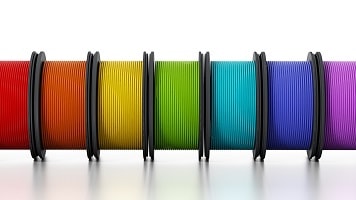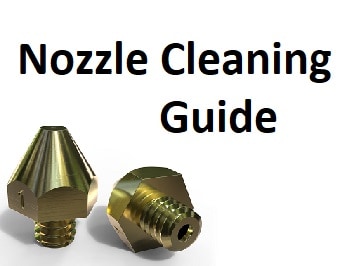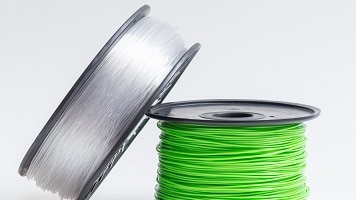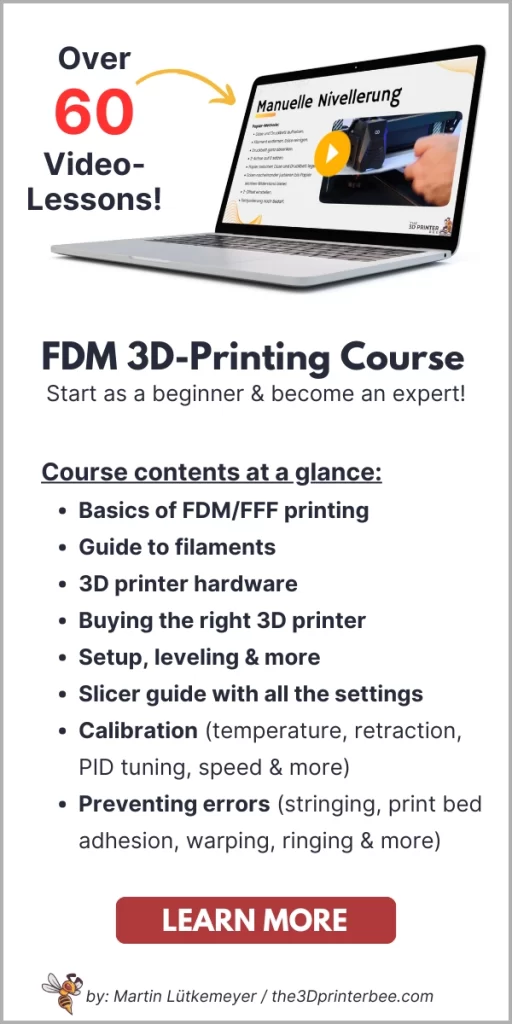- Wet Filament: Prevention, Symptoms & Drying - July 18, 2024
- Sovol SV08 – Best PrusaSlicer Settings & Profile - June 26, 2024
- Sovol SV08 – Best Orca Slicer Settings & Profile - June 26, 2024
Disclosure: Links marked with * are Affiliate Links. I earn from qualifying purchases if you decide to make a purchase through these links – at no additional cost for you!
Filaments for 3D printing not only have different colors but also different printing properties. Our guide offers you a comparison between the materials PLA, ABS, PETG and TPU.
We offer you valuable information regarding these filaments, show the respective properties and explain the respective fields of application.
| Name | PLA | ABS | PETG | TPU |
|---|---|---|---|---|
| Printing Temperature | 180 - 230 °C | 210 - 250 °C | 200 - 260 °C | 190 - 245 °C |
| Printing bed Temp. | 20 - 60 °C | 80 - 110 °C | 80 - 90 °C | 60 - 90 °C |
| Printing Bed | optional | necessary | optional | optional |
| Bed Adhesion | medium | medium | bad (use blue tape or PEI) | bad (use blue tape or PEI) |
| Fumes | few to none | harmful | harmful | few to none |
| Absorption of Moisture | yes | yes | yes | yes |
| Strength | medium | good | very good (except scratches) | very good |
| Flexibility | bad | medium | good | perfect |
| Heat Resistance | bad | medium | good | good |
| UV-Resistance | medium | medium | medium | good |
| Water Resistance | medium | medium | good | good |
| Biodegradable | partly | no | no | no |
| Recyclable | yes | yes | yes | yes |
| Gluing and Painting | possible | possible | possible | possible |
| Acetone Treatment | not possible | possible | not possible | possible |
| Colors | large selection | large selection | large selection | large selection |
Table of Contents:
- 1 PLA versus ABS
- 1.1 PLA
- 1.2 ABS
- 1.3 PLA versus ABS at a glance
- 1.3.1 PLA versus ABS – Strength
- 1.3.2 PLA versus ABS – Surface Finish
- 1.3.3 PLA versus ABS – Durability
- 1.3.4 PLA versus ABS – Flexibility
- 1.3.5 PLA versus ABS – Heat Resistance
- 1.3.6 PLA versus ABS – Mechanical Stress Resistance
- 1.3.7 PLA versus ABS – Melting Point
- 1.3.8 PLA versus ABS – Glass Transition and Printing Temperature
- 1.3.9 PLA versus ABS – Risk of Nozzle Clogging
- 1.3.10 PLA versus ABS – Printing Bed
- 1.3.11 PLA versus ABS – Printing Space
- 1.3.12 PLA versus ABS – Layer Adhesion
- 1.3.13 PLA versus ABS – Fumes
- 1.3.14 PLA versus ABS – Storage
- 1.3.15 PLA versus ABS – Mechanical Properties
- 1.3.16 PLA versus ABS – Durability and Disposal
- 1.3.17 PLA versus ABS – Refinement and Finishing
- 1.3.18 PLA versus ABS – Colors
- 1.3.19 PLA versus ABS – Price
- 1.3.20 PLA versus ABS – Fields of Application
- 1.3.21 PLA versus ABS – Beginner Friendliness
- 1.4 Important Facts at a Glance – Table PLA vs ABS
- 2 PETG
- 2.1 Advantages of the Allround-Filament
- 2.1.1 Recycling
- 2.1.2 Mechanical properties of PETG
- 2.1.3 Printing Temperature and Crystallization
- 2.1.4 Removing the Object from the Printing Plate
- 2.1.5 Heated Printing Bed Only Partly Necessary
- 2.1.6 Low Viscosity
- 2.1.7 Toughness, Elasticity and Breaking Strength
- 2.1.8 Transparency
- 2.1.9 Weather Resistance
- 2.1.10 Beginners, Schools and Universities
- 2.1.11 Print Temperature
- 2.1.12 Diameter
- 2.1.13 Colors
- 2.1.14 Layer Adhesion
- 2.1.15 No Warping
- 2.1.16 Uncomplicated Loosening
- 2.1.17 Resistance to Chemicals and Solvents
- 2.1.18 Combination of the Positive Properties of PLA and ABS
- 2.2 Disadvantages of PETG
- 2.3 Important Facts about PETG at a Glance
- 2.4 Summary – PLA versus PETG
- 2.1 Advantages of the Allround-Filament
- 3 TPU
- 4 PLA versus ABS, PETG and TPU
PLA versus ABS
These two materials are among the most popular filaments in 3D printing. Both filaments are thermoplastics that can be shaped in a hot state and retain this shape after cooling.
Besides this basic similarity, PLA and ABS have numerous differences which we would like to point out to you.
PLA
Polylactic acid is among the biodegradable thermoplastics. PLA is produced from renewable resources such as sugar cane and corn starch.
The main advantage of PLA is that this filament is extremely easy to print and is also ideal for beginners.
What is PLA used for?
- Models
- Figures
- Prototypes
- Container
- Toys that are not heavily used
ABS
Acrylonitrile butadiene styrene is one of the petroleum-based thermoplastics. ABS is a filament that exhibits particularly high strength, resistance and flexibility.
What is ABS used for?
- Smartphone sleeves
- Tool handles
- Toys
- Housing for electronics
- Interior equipment for the vehicle
- Interlocking parts like gears
PLA versus ABS at a glance
We would now like to show you the differences between the two most popular 3D filaments at a glance.
PLA versus ABS – Strength
PLA is ideal for all 3D prints that do not have high strength.
Compared to PLA, ABS prints have high strength.
PLA versus ABS – Surface Finish
In addition, the use of PLA is recommended for three-dimensional prints that do not require a special surface finish.
PLA versus ABS – Durability
PLA has lower durability than ABS. This means that prints made from PLA are less durable.
PLA versus ABS – Flexibility
PLA is not recommended for printed parts that are to be bent, while ABS is suitable for flexible three-dimensional prints.
PLA versus ABS – Heat Resistance
Because PLA is not too heat-resistant, you should never use this filament for 3D prints that are exposed to direct sunlight.
Nor is PLA suitable for components that are connected to a device that heats up.
In contrast, ABS has high heat resistance.
PLA versus ABS – Mechanical Stress Resistance
PLA is much less resilient than ABS and therefore you cannot make objects out of this material that have to withstand high loads.
In addition, this filament is not suitable for prints that are subject to increased vibration.
This means that PLA is not suitable for printing covers for your smartphone, nor for making toys or tool handles.
ABS filament is ideal for components that are subject to high loads.
PLA versus ABS – Melting Point
Both plastics melt when heated, but the melting point of PLA and ABS is different. The points between the glass transition and melting temperature have a direct influence on the temperature of the printing bed and the print.
It is important that the temperature of the printing bed remains well below the glass transition temperature. This is the only way to ensure that the printing process is not disturbed.
PLA versus ABS – Glass Transition and Printing Temperature
Because of the low glass transition and printing temperature, PLA printing generally requires less heat than ABS printing.
ABS is a purely amorphous substance that has no real melting temperature. ABS usually liquefies well below the recommended printing temperature.
PLA versus ABS – Risk of Nozzle Clogging
A disadvantage of PLA is that this filament can clog the nozzle of your extruder. The reason for this is that the material expands when melting. PLA is particularly sticky when melted and therefore the flow of liquid PLA through the nozzle can be disrupted. You can prevent the nozzle from clogging by making certain adjustments.
If you use ABS, the problem of a clogged nozzle does not occur. This is because the printing temperature is higher.
PLA versus ABS – Printing Bed
ABS is much more susceptible to material distortion than the filament PLA.
This point speaks clearly in favor of PLA, since this material is not sensitive to temperature fluctuations, you can do without a heated printing bed.
Using a heated printing bed for PLA printing can be helpful, but it is not absolutely necessary.
PLA versus ABS – Printing Space
If you print with PLA, your 3D printer does not necessarily need a closed printing space.
Since ABS, unlike PLA, is more susceptible to temperature changes, ABS prints may show cracks. Likewise, the risk of material distortion is higher with ABS than with PLA.
A closed housing is recommended for printing with ABS.
PLA versus ABS – Layer Adhesion
Both filaments have problems with regard to the adhesion of the first printing layer. These are expressed by the fact that the first print layer can adhere to the printing bed and the component is very difficult to detach from the printing bed after printing.
There are three possible solutions for these problems.
- You can put adhesive tape on your printing bed.
- Alternatively, you can treat your print bed with hairspray.
- The third solution is to apply liquid glue to your printing bed.
PLA versus ABS – Fumes
The biodegradable PLA filament does not emit intense fumes that are harmful to your health when heated. You will only notice a fruity and sweet smell when you heat PLA.
ABS, on the other hand, emits intense vapors when heated, which can cause headaches. Make sure that you ventilate the room very well when heating. Alternatively, you can make your 3D prints in a large and very well insulated room with excellent ventilation.
PLA versus ABS – Storage
Both filaments are hygroscopic. This means that they attract and absorb moisture from the air.
With both materials the print quality decreases due to the moisture absorbed.
With PLA and ABS, bubbles can form in the nozzle due to the moisture absorbed. This means that in both PLA and ABS, the molten material can escape uncontrollably and clog the nozzle. This has a negative effect on your end product, as it can discolor. In addition, the layers can have irregularities.
Therefore, you should not store PLA or ABS in open storage. Seal both filaments in airtight bags or containers and store the materials in a cool and dark place.
PLA versus ABS – Mechanical Properties
ABS owes its high strength to polybutadiene. This is a synthetic rubber that has a high resistance to wear. ABS has high impact strength and enormous strength.
Although there are much more flexible materials than ABS, ABS is much more flexible than PLA. Unlike PLA filament, 3D prints made from ABS can be distorted and bent before they break.
PLA offers a mechanical advantage over ABS. This is the higher surface hardness. Otherwise, the strength of PLA is quite low and this material is considered brittle.
PLA versus ABS – Durability and Disposal
In general, 3D prints made from ABS are much more durable than those made from PLA, as ABS is more heat resistant. Objects made of ABS can be exposed to the sun, while prints made of PLA should be protected from direct sunlight.
However, keep in mind that UV rays, as well as wetness, negatively affect the quality of both PLA and ABS.
PLA is characterized by biodegradability. This means that you can dispose of components made of PLA in compost, provided that they are collected by the waste collection service and recycled accordingly. Components made of ABS must be recycled with other plastics.
PLA versus ABS – Refinement and Finishing
If you are willing to invest a lot of time in post-processing, you are better off with ABS than with PLA.
You can cut, glue, file, polish and paint both filaments after printing with acrylic paint, but gluing and coloring PLA prints proves to be more difficult.
Prints made from ABS can be treated with acetone, unlike PLA, to create a glossy and smooth surface.
From PLA you can create complicated designs.
PLA versus ABS – Colors
PLA and ABS are offered in different colors. You can also choose transparent filament.
Exotic filaments are available both ABS-based and PLA-based.
PLA versus ABS – Price
The price difference between PLA and ABS is small. For exotic materials based on PLA and ABS you have to dig a little deeper into your pocket.
PLA versus ABS – Fields of Application
PLA is the most popular filament as it is ideal for beginners and printing is easy. Prints made from PLA filament are ideal if you don’t need a special surface finish, durability and strength.
As long as your objects are not bent and exposed to vibrations and heat, PLA is the ideal choice.
ABS is suitable for objects that are heavily loaded, bent and used more often. ABS prints are also used for mechanical components. ABS filament is also recommended for interlocking parts such as gear wheels.
PLA versus ABS – Beginner Friendliness
While PLA is ideal for beginners, the printing process is a little more complicated with ABS.
Important Facts at a Glance – Table PLA vs ABS
| Name | PLA | ABS |
|---|---|---|
| Printing Temperature | 180 - 230 °C | 210 - 250 °C |
| Printing bed Temp. | 20 - 60 °C | 80 - 110 °C |
| Glass transition temperature | 57 °C | 104 °C |
| Printing Bed | optional | necessary |
| Closed Printing Space | optional | recommended |
| Nozzle Clogging | every now and then | almost never |
| Bed Adhesion | possibly small problems | possibly small problems |
| Fumes | few to none | intensive and harmful to health |
| Absorption of Moisture | yes | yes |
| Strength | medium | good |
| Flexibility | brittle | somewhat flexible |
| Heat Resistance | bad | medium |
| UV-Resistance | medium | medium |
| Water Resistance | medium | medium |
| Biodegradable | partly | no |
| Recyclable | yes | yes |
| Gluing and Painting | possible | possible |
| Acetone Treatment | not possible | possible |
| Colors | large selection | large selection |
PETG
PET is a polyethylene terephthalate. This is a polymer which belongs to the group of polyesters. The thermoplastic is modified with glycol. The glycol modification becomes clear in the designation PETG.
Advantages of the Allround-Filament
PETG offers a variety of advantages in three-dimensional printing.
Recycling
Although PETG is recyclable, this filament cannot be biodegraded.
Mechanical properties of PETG
PETG is extremely durable and surpasses PLA in this respect. PETG is also longer lasting and much more robust than PLA.
In contrast to PLA surfaces, the surfaces of objects made of PETG are much more susceptible to minor damage and scratches.
The polyethylene terephthalate modified with glycol has an enormous toughness.
The special thing about three-dimensional prints made of PETG is their weather resistance.
Printing Temperature and Crystallization
The added glycol ensures that the printing temperature is low. In addition, glycol causes the crystallization to be lowered. These two factors drastically improve the printing properties of PET.
Removing the Object from the Printing Plate
Due to the low printing temperature and the minimized crystallization, you can remove your finished prints more easily from your printing plate after cooling down.
Heated Printing Bed Only Partly Necessary
On the positive side, you can partially do without a heated printing bed for printing with PETG. A heated printing bed is only necessary for some PETG variants. When using a heated printing bed, note that the PETG soft point is between 80 and 90 degrees Celsius.
Low Viscosity
Glycol also has low viscosity properties. Viscosity describes how viscous a material is, while high viscosity means that a material is not liquid. Since PETG is low viscosity, this material is a liquid when heated.
This makes the printing process faster and the printing process easier. Unlike other filaments, you can achieve high printing speeds of up to 100 millimeters per second. As a result, you need to spend less time printing your 3D object.
Toughness, Elasticity and Breaking Strength
PETG is a tough filament, which has both high elasticity and an enormous breaking strength. This thermoplastic material is characterized by high reliability.
Transparency
PETG is a transparent filament.
Weather Resistance
Unlike PLA and ABS filament, PETG is weather resistant and suitable for outdoor use.
Beginners, Schools and Universities
Since this filament is easy to print, even beginners can easily print with PETG. PETG is also the ideal choice for printing in schools or universities.
Print Temperature
The printing temperature of PETG is between 200 and 260 degrees Celsius.
Diameter
PETG filament has a diameter of either 1.75 or 2.85 millimeters.
Colors
PETG is available in many color shades. You can choose between white, yellow, orange, red and purple filament. You can also choose between purple, green, blue and black filament.
Alternatively, you can opt for uncolored, colored, transparent PETG. PETG is also available in metallic.
Layer Adhesion
PETG filament has excellent layer adhesion. Therefore this filament enables an excellent optical printing result.
No Warping
It should be emphasized that this material does not tend to warp. You benefit from the fact that your objects do not bulge. The shrinkage is extremely low, at only 0.5 percent. In contrast, ABS printing can cause bulging and there is a risk that the objects will shrink after cooling down.
Uncomplicated Loosening
Detaching PETG objects from the printing bed is easy and further processing is also straightforward. You can grind PETG-prints excellently.
Resistance to Chemicals and Solvents
It should be emphasized that polyethylene terephthalate is resistant to most chemicals and solvents.
Combination of the Positive Properties of PLA and ABS
- PETG combines the strengths of the two popular filaments PLA and ABS.
- PETG is as easy to print as PLA. In addition, the shrinkage behavior is just as low as that of PLA.
- The breaking strength, temperature resistance and durability are even higher than those of ABS.
- Just like PLA and ABS, PETG is resistant to oils, alcohols, solvents and many acids.
- Objects printed from PETG do not become cloudy or brittle thanks to the addition of glycol.
- If the workplace is hygienically clean, it is even possible to sterilize the print object and use it for medical technology.
- PETG prints not only have the advantage of being resistant to chemicals, but are also flame retardant. PETG objects belong to level B1 in terms of flammability.
Disadvantages of PETG
The thermoplastic material has only a few weak points:
Not Completely UV-Resistant
PETG is not completely UV resistant. This means that objects made of PETG can be weakened by UV light. Therefore, you should not expose these print objects to intensive UV radiation for a long time.
Susceptible Surface
Objects printed from PETG have a vulnerable surface. Scratches and slight damage are common if you do not do any rework. However, you can protect the PETG surface from scratches by applying a clear coat.
Problems with the Hotend
Another weakness in PETG printing is the potential problems with the hot end.
These problems usually occur when the temperature curve is flat, as the thermal barrier may not function as desired. If the thermal barrier is disturbed, the PETG material becomes soft already at the cold end. This can cause blockages of the nozzle.
Stringing
One downer is that PETG tends to pull strings. You can prevent this unpleasant stringing by changing the retraction settings and running the fan at full power except in the first layer.
Poor Adhesion of the First Layers
In contrast to PLA filament, PETG has poorer adhesion in the first layer. Some users recommend printing with a little more space in the first layer so that the first filament layer on your printing bed is only laid down and not squashed.
However, the opposite effect, i.e. squeezing the first filament layer, can also lead to better adhesion of the first layers.
PETG has excellent adhesion to substrates such as Blue Tape and PEI. Therefore, you can apply an intermediate layer of glue stick, hair spray or wood glue on your printing bed, so that you do not have to tear off your printing object when removing it.
Attraction of Water Molecules
PETG absorbs water molecules from the surrounding air and has to be stored airtight. When PETG filament absorbs water, tiny bubbles are formed in the material, which evaporate when heated and can disturb the filament flow.
In addition, the water bubbles can give the surface an unclean appearance and minimize layer adhesion.
Food Safety
A positive feature of PETG is that this filament is food safe and is classified as safe, even if this raw material comes from different countries.
Nevertheless, pay attention to the manufacturer’s instructions so that you know whether you can use the respective PETG filament for food containers, crockery, cutlery, cooking and baking utensils.
Keep in mind that bacteria and germs can increasingly settle in the microscopic cracks and depressions of the PETG object.
Important Facts about PETG at a Glance
- Chemical name: Polyethylene terephthalate glycol
- Printing speed: 40 to 100 millimeters per second
- Density: 1.20 to 1.28 grams per cubic centimeter
- Melting temperature: 195 to 260 degrees Celsius
- Heating bed temperature: if necessary between 60 and 85 degrees Celsius
- Flammability: less flammable – Building material class B1
- Weather resistance: generally good – but reacts with UV light
- Heat deflection temperature: 63 to 85 degrees Celsius
- Impact strength: about 8 KJ/m2
- Flexural modulus: about 2
Summary – PLA versus PETG
- In terms of handling, PLA is easier than PETG. Moreover, PLA even forgives small printing errors.
- With both filaments, the material distortion after cooling is low.
- Both PLA and PETG are food safe.
- In contrast to PLA material, PETG is more robust, more durable and can withstand higher loads.
- The surface of PLA prints is less susceptible to scratches and damage than that of PETG.
- In terms of acquisition costs, PLA is cheaper than PETG filament.
TPU
Thermoplastic polyurethane is a urethane-based elastomer that has similarities to rubber. This filament is perfect for making protective housings or shock absorbers.
Thanks to its enormous elasticity, the print proves to be complicated and is not suitable for beginners.
If you have a 3D printer with Bowden cable feed, you have to modify your hardware. Since not all 3D printers are capable of printing TPU, you should check if your printer can print TPU before you buy TPU filament.
Advantages of TPU
TPU is a material with a number of advantages.
High Resistance and Abrasion Resistance
This popular 3D filament is characterized by its enormous resistance to chemicals, oil and grease.
TPU also has a high abrasion resistance.
Not Harmful to Health and Low Odor Development
This material is not harmful to health compared to ABS filament and even allergy sufferers and people who suffer from allergies can perform 3D prints with TPU.
It should be emphasized that only slight odors develop when TPU is heated.
Flexibility
While PLA and ABS have low flexibility, objects printed from TPU are much more flexible and you can even bend them. Despite the high degree of flexibility, there is no loss of durability, strength or design.
Cleaning
You can clean TPU objects quickly and easily with mild soap.
UV- and Weathering Resistance
TPU offers the advantage that this filament is UV-resistant. Objects made of TPU have a high resistance to weathering.
Printing Temperature
The printing temperature depends on the respective TPU filament and the manufacturer. The printing temperature range is between 190 and 245 degrees Celsius.
Printing Bed Not Absolutely Necessary
In general, you can use TPU without a heated printing bed, but it is advisable to use a heated printing bed. The best results are achieved with a heated printing bed between 60 and 90 degrees Celsius.
Enormous Choice of Colors
Advantageous is the enormous choice of colors. However, it has to be said that the colors are less flashy than those of other filaments. You can use not only colored TPU, but also milky transparent ones.
Disadvantages of TPU
Three-dimensional printing with TPU has one or two disadvantages:
Cooling
You should use a fan for cooling the TPU-Print.
Price
TPU is significantly more expensive than ABS, PLA and PETG.
Biodegradability
TPU is not biodegradable.
Not Suitable for all 3D Printers
This filament cannot be processed by all 3D printers.
PLA versus ABS, PETG and TPU
If you want to add flexibility to your three-dimensional objects, TPU is the right choice. TPU is suitable for flexible parts that should return to their original state after bending.
As a beginner, PLA is preferable, as printing with TPU is much more difficult and requires some experience.
You can use PLA for model making and prototypes because the material costs are low and printing is easy.
If your printer has a heatable bed and you want to increase durability, ABS is the right choice.
PETG is the right choice for printing vases and semi-transparent covers for lamps.
If you want to print a protective cover for your smartphone or action cam, you should use TPU.

Related Post:
40 Types of 3D Printer Filaments – List, Uses & Guide
Disclosure: This website is the property of Martin Lütkemeyer and is operated by Martin Lütkemeyer. Martin Lütkemeyer is a member of the Amazon Services LLC and other Affiliate Programs. These are affiliate advertising programs designed to enable websites to earn advertising revenue through advertising and linking to Amazon.com and others. Links marked with * are affiliate links.





